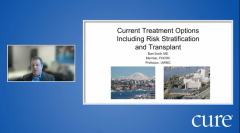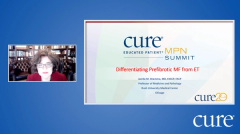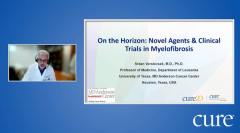
Educated Patient® MPN Summit Novel Agents & Clinical Trials in Myelofibrosis Presentation: May 7, 2022
Watch Dr. Srdan Vestovsek, from The University of Texas MD Anderson Cancer Center, discuss novel agents and clinical trials in myelofibrosis, during the CURE Educated Patient MPN Summit.
Episodes in this series

Myelofibrosis, a type of myeloproliferative neoplasm (MPN), tends to have a poor prognosis and high symptom burden compared to other types of MPNs, though up-and-coming treatments will hopefully increase survival while also improving the quality of life of patients with the disease, explained Dr. Srdan Verstovsek, a professor of medicine in the Leukemia Department at The University of Texas MD Anderson Cancer Center.
In CURE®’s recent Educated Patient ® MPN Summit, Verstovsek discussed what’s on the horizon for myelofibrosis.
“Myelofibrosis is the deadliest myeloproliferative neoplasm; average survival is about five to seven years, and much is needed to change that outcome,” Verstovsek said in an interview with CURE® after his presentation.
JAK Inhibitor Combinations
Currently, myelofibrosis is treated by inhibiting the JAK/STAT pathway, which leads to inflammation. There are three Food and Drug Administration (FDA)-approved drugs that do this: Jakafi (ruxolitinib), Inrebic (fedratinib) and Vonjo (pacritinib). While these work to improve quality of life and help patients to potentially live a few years longer, they only work for an average of about three years, highlighting the need for further lines of treatment, according to Verstovsek.
“But still, we need to make a major change in the overall outcomes by possibly adding medications to JAK inhibitors or for when they don’t work anymore,” he said.
While JAK inhibitors are more generalized and do not target a specific mutation, phase 3 trials are investigating if the addition of other drugs, like navitoclax, pelabresib or parsaclisib, can help Jakafi work better or longer.
When JAK Inhibitors Stop Working
When myelofibrosis completely stops responding to JAK inhibition, “We still have a symptom problem, we still have spleen (enlargement), and we still have anemia, but it’s much worse, and life is short. So there are therapies (being studied) like nevtemadlin to control the symptoms and imtelstat, which is to prolong the life of these patients,” Verstovsek said.
Navtemadlin (KRY-232) is a new drug that is being explored in this setting. It inhibits MDM2, a gene that is important in cancer cell survival.
Imtelstat, on the other hand, inhibits the enzyme that maintains the DNA at the end of chromosomes when cells divide. Without this DNA, the cells cannot proliferate and they end of dying.
“Within the next three years, we’ll have a number of combinations and options to give our patients,” Verstovsek said.
Targeting Bone Marrow
Myelofibrosis occurs in the bone marrow, so one new treatment strategy is looking at how to attack the disease where it occurs.
PRM-151 is a novel drug that inhibits the differentiations of blood cells. It prevents monocytes from becoming fibers, which can lead to myelofibrosis — hence “fibrosis” in the disease name.
“If you can tackle the fibers, or understand the microenvironment where that happens, that would be another angle of helping these patients,” Verstovsek said.
While the drug reversed fibrosis in pre-clinical models, it is still far off from gaining FDA approval for the treatment of humans.
Looking Ahead
Ultimately, Verstovsek is hoping that upcoming years will bring better, more targeted therapies to patients with myelofibrosis.
“While there are hopes about reaching that stage where we can actually work on the DNA itself, I think it’s much more realistic that over the next few years, we are in a situation to start talking about targeting malignant cells by virtue of identifying a marker on them to distinguish them from normal cells and be much more successful in (treatment),” he said.
Though JAK inhibitors are still the mainstay, up-and-coming approvals can make their use even better.
“It is quite thrilling to expand where we are with JAK inhibitors, improving quality of life, maybe making people live longer for a few years, but then also talking about new drugs that are close to approval.”
For more news on cancer updates, research and education, don’t forget to














